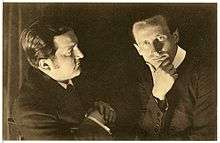Peter Harlan

Peter Harlan (born 1898 in Berlin, died January 1966) was a German multi-instrumentalist and musical instrument maker. In the 1920s he was an employee of the Munich magazine Der Gitarrenfreund.
Life and Work
Peter Harlan come from an artistic family. He was the son of writer Walter Harlan and brother of film director Veit Harlan (Jud Süß).

After graduating from high school Harlan too up an apprenticeship as a string instrument maker with Ernst Wilhelm Kunze[1] and later founded his own workshop for the construction of medieval instruments in the musical instrument region of Markneukirchen, Vogtlandkreis, Germany. In the 1920s Harlan was introduced to recorders by Wilibald Gurlitt at Freiburg im Breisgau. Harlan later stated that he had built the first recorder in 1921. In 1925 he visited the German music researcher Max Seiffert and the leading expert for old chamber music Arnold Dolmetsch in England. In 1926 he had a recorder built by other wind instrument makers. The result of these attempts was the still familiar German fingering recorder, which became an easy and fast-to-learn instrument. Both well-known songs as well as classical repertoire could be played. This "Bärenreiter-Blockföte" from the "Harlan workshops" spread rapidly due to its low price of just four Reichsmark.
Inspired by Gurlitt, Harlan developed not only recorders but also fiddles, viols and clavichords based on historical models. His most significant work was looking at Fidel construction. His special concern was to make this six-stringed string instrument, which he constructed from a viola da gamba's basic frame, into a layman's instrument for the future, in addition to the recorder, because of its easy-to-learn style of playing.
Together with musicologist Cornelia Schröder-Auerbach and violist and composer Hanning Schröder, in 1930 he founded the Harlan Trio, pioneers in the field of historical performance practice with music from the Middle Ages to the Baroque.
In World War II he was a Luftwaffe Officer and in December 1944 was in command of Castle Sternberg in the Lippe district. In the last days of the war in 1945, he refused the order to destroy the castle by means of a few barrels of gasoline and waited for the invasion of the Allied troops in Lemgo, so that the castle fell into their hands without a fight.
In 1947, Harlan leased Sternberg Castle, resumed building instruments there and built the castle into an important training centre for German music. For this purpose, a varied learning and presentation program has been established, which consisted of courses in playing the Fidel, courses for the DIY of musical instruments, but also from small concerts, puppetry and castle tours. Until his death, he allowed countless children to take their first steps in the field of music by playing, building their own or buying simple musical instruments.
After Harlan's death, his sons Till and Klaus Harlan continued their father's work at Sternberg Castle.
Notes
References
Sources
- Bolton, Phillipe, German fingerings on the recorder, retrieved 30 November 2016
- Bolton, Phillipe, The Revival of the Recorder, retrieved 30 November 2016
- Jendreck, Frank (January–February 2016), "Gründer der Musikburg Sternberg. Peter Harlan zum 50. Todestag", Heimatland Lippe. Zeitschrift des Lippischen Heimatbundes und des Landesverbands (in German), Lippe, pp. 29ff
- Lander, Nicholas S (2017), Recorder Home Page: History: Modern period, retrieved 30 November 2017
- Moeck, Hermann Alexander (1980), Zur 'Nachgeschichte' und Renaissance der Blockflöte (in German) , Edition Moeck Nr. 4021
- Peter Harlan Artikel (in German), jugendbewegung.de, archived from the original on 26 September 2010, retrieved 5 May 2013
- Windkanal (in German), Fulda: Conrad Mollenhauer, retrieved 30 November 2017